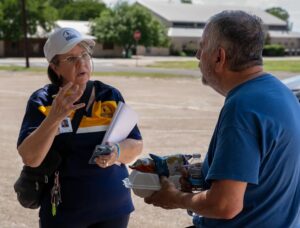
KANSAS CITY, Mo. (BP)–A recognition of television’s influence on modern communication should prompt preachers to shift from a rhetorical style to a more conversational model in order to reach the audience, declared an expert on preaching technique.
For some, change will be frightening, while others will find encouragement in its challenge, said Haddon Robinson, professor of homiletics at Gordon-Conwell Theological Seminary, South Hamilton, Mass., who delivered the 1997 Hester Lectures on Preaching Feb. 26-27 at Midwestern Baptist Theological Seminary, Kansas City, Mo.
Robinson, who urged seminarians to hold on to their allegiance to the Word of God in coping with changes in the way people communicate, spoke from his field of expertise in studying, writing and teaching about communication as practiced by preachers. “That’s where I live, where I spend my life.”
He traced the transition of communication through an oral culture, by which one generation passed down their beliefs and stories to another, to the introduction of the printing press, which impacted the entire world as an instrument of communication.
“Books took the place of memory,” he recounted.
In addition to the printing press, communication was changed through the introduction of the telegraph, radio and ultimately television. “I would argue that television has had as great an influence on the thinking of people in the U.S. and Britain as the printing press had on the people of the 16th and 17th centuries,” he said.
While many Christians object to such a pervasive influence, Robinson argued, “Whether it’s good or bad, you and your people are fashioned by television.” Today’s churchgoers “can’t shift their minds into some other mode.” Because television, with its focus on stories, is the dominant communications device of our time, Robinson insisted “preaching that does not take seriously the narrative and the use of stories does not communicate with this generation.”
The recognition that people don’t get their information by reading should influence expository preaching, he continued. Assumptions must not be made as to the ability of a congregation to follow a text, when an estimated 27 million Americans are functionally illiterate. Many more are behaviorally illiterate, he said, having chosen to limit their intake of written material to “headlines and box scores.”
In how a preacher addresses the spiritual lives of people, Robinson said, “If I say that in order to grow spiritually you have to read and study and understand the Bible, I may be asking them to do what they may not be able to do.” Preachers should recognize that the Bible “is a tough read” for most people, he said.
Utilization of stories in preaching helps the preacher communicate by “bringing the message down to concrete, specific images,” Robinson said.
Furthermore, the effective preacher will move away from lecture and closer to conversation, he added, encouraging preachers to study eye contact, variety of rate, and pitch.
“What you don’t get on television is yelling people,” Robinson contended, noting such a delivery style began during an era prior to public address systems. Many preachers unthinkingly remain in that tradition, never having adjusted their voice level for modern amplification, he said. Preaching today is not haranguing, scolding and yelling. It’s talking with people.”
Even the use of a large pulpit is a tradition that conveys authority borrowed from a time when ships lacked radar, requiring a sailor to stand in the “pulpit” at the front to relate directions. “It doesn’t work today,” Robinson said. “A large pulpit stands between you and the people.”
An understanding of the impact of television on the culture also has an implication for sermon construction, Robinson said, noting television is inductive, rather than deductive. “A story starts, builds tension and ultimately is resolved.”
Robinson rejected an insistence on a sermon form that requires a deductive approach with three points. Such methodology originated with early church leaders schooled in pagan rhetoric, who stated a proposition, explained and then proved it.
“The only question you have as a communicator is what does it take to communicate this truth to this audience so that they will understand and see how it relates to their lives.” Sermon preparation should focus on a study of the text and determining how to best communicate the point, he said.
“Try to understand what the ancient writer is saying to the reader,” Robinson explained, “always mining theology.” Then ask, “Given this, how do I get this across to people?” he continued. “If you think that by beginning with a skit, a drama, you can speak to that as a way to getting this truth across, by all means use it,” Robinson said. The use of a first-person narrative, overhead transparencies or slide projection may effectively communicate the message, he added.
“Let me tell you what you can’t do and be true to Scripture,” he warned. “You can’t begin by saying, ‘I’ve got to preach a sermon next Sunday. How can I make it interesting and clever. I think people are suffering from bad self-images so I’ll go to the Bible and get something on self-image. And I’m not sure where it is, but here’s a verse that sounds like it.’
“Whenever you bring this process to bear on the study, you will almost always pervert this study,” Robinson said. “I am not saying you start with communication and you think about form. You start with the biblical text and understand its theology, its idea, its purpose, how the biblical writer is getting something across and how can I communicate that to people today.”
Robinson insisted preachers have “an allegiance to the Word of God that’s unflinchable.” He said he doesn’t just talk to people about the Bible. “I talk to them … from the Bible in ways they understand.”
Thinking about ways to take the truth of Scripture and getting it across to the audience is “always the preacher’s struggle” and, ultimately, “the preacher’s glory.”
Robinson prayed students preparing for a preaching ministry might be “people of the Scriptures” as well as “people of the people,” able to bring the two together “to avoid wasting our lives in ineffectiveness.”
–30–














